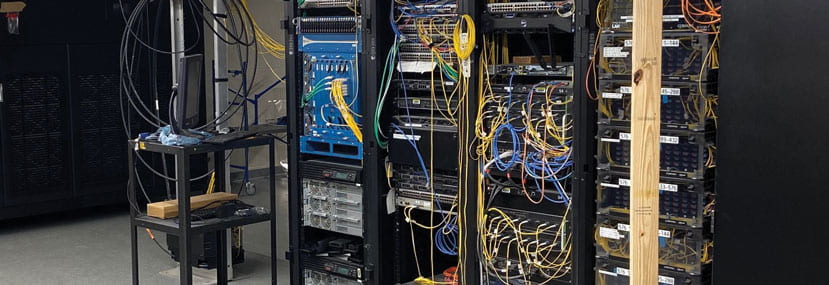
IHub–Data Center Relocation
The decommissioning of the UMass Boston Science Building posed monumental challenges for IT, among them the need to downsize and relocate the critical campus IT data center. Anyone who has ever moved from a large home to a smaller one knows the difficulties inherent in what is now respectfully known as “rightsizing.”
In IT’s case, the move reduced the Science Building’s 3,400-square-foot data center footprint to a 1,000-square-foot space, necessitating virtualizing and moving non-IT-administrated servers to several different IT-supported critical facility locations across campus. Once these servers were successfully relocated, the team pivoted to moving the core IT servers, network, security, and all critical hardware to their new home in the new IHub (Infrastructure Hub) located in the Quinn Administration Building. In somewhat of an understatement, Terrence Phalen, director of the Project Management Office, said, “There were a lot of complexities, lots of moving parts.”
Jamie Soule, director of Network Services, was fully involved in the project. “One of my roles, and I’ve been doing it for 25 years at UMB, is designing, maintaining, and managing the campus data center(s), which is the technology hub of the campus. It connects all the buildings, networks, phone systems, data storage, internet service provider … Everything.
“You could call it the IT engine room of the campus,” he said. “Moving the data center was an extraordinarily complex process. It involved moving equipment not intended to be shut down, equipment that virtually everyone relies on, and it had to be done in a way that was organized, planned, and well thought out.” And even then, he said, “You need to have contingency plans for everything, a time-consuming process in and of itself. The planning for the relocation of the Science Building data center literally began in 2019.”
Critical to a reliable and well-functioning new data center location—the IHub—is reliable electrical and cooling equipment, tight security, and high-bandwidth network access, just for starters. To help guide the process, IT partnered with the UMass Boston facilities team and BVH, a design and engineering firm. Soule was instrumental in identifying a suitable space on campus and helping determine the size of the new facility. Eventually, it was decided to transform the old Quinn campus telecom phone room into the new IHub data center facility.
At the risk of oversimplifying, once these basics were solidified, the new space was readied for construction. IT collaborated closely with Shaun Curry, director of project management for facilities, to ensure successful implementation of the plans.
“We kept an open conduit of communication,” said Curry. “Any questions by the contractor were reviewed by IT. We worked closely with Jamie Soule. He had a great idea of what IT wanted and what needed to happen. Jamie was incredibly diligent working with us and the designer to make sure the end product would meet the needs of the university.”
Curry said that smooth collaborations with IT was key in getting the job done and getting it done right. “IT was the content expert; Facilities had knowledge of how construction contracting works for the Commonwealth,” he said.
“Anytime you take down a critical data center, there are a lot of challenges,” said Phalen. “For UMass Boston to go offline in the middle of a semester would have been catastrophic. So, we designed our move in such a way that services could be retained. Consequently, the move occurred with very little impact to our users.”
“Essentially, the actual move broke down into two groups: the systems group and a combination of the network, security, and operations teams,” said Brian Forbes, director of Systems. “Jamie Soule is outstanding. He knows the physical infrastructure better than anyone. My group was responsible for moving the server operation and making sure the connectivity worked.”
“The majority of work in a project like this is behind the curtain,” said Phalen.
And while the new IHub is humming along, and it is business as usual for members of the university community, the teams look to future needs.
“We continue to reduce our footprint by moving physical and virtual servers offsite to DC02, which is an offsite data center environment hosted by the university medical school. Newly virtualized equipment fits into a much smaller and more effective space,” said Phalen, yet another example of the speed with which technology can change the business landscape, making things ever more effi-cient for those of us who rely on efficiency.